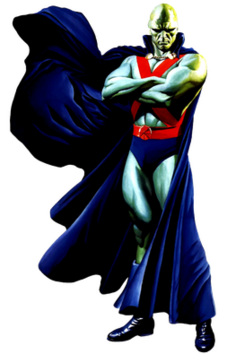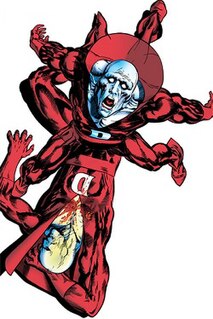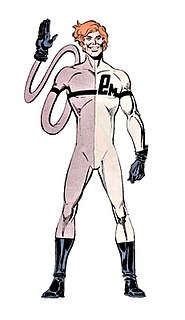Related Research Articles

The Martian Manhunter is a fictional superhero appearing in American comic books published by DC Comics. Created by writer Joseph Samachson and designed by artist Joe Certa, the character first appeared in the story "The Manhunter from Mars" in Detective Comics #225. Martian Manhunter is one of the seven original members of the Justice League of America and one of the most powerful beings in the DC Universe.

Deadman is a fictional superhero appearing in American comic books published by DC Comics. He first appeared in Strange Adventures #205, and was created by Arnold Drake and Carmine Infantino.

Elongated Man is a fictional character, a superhero appearing in American comic books published by DC Comics. His first appearance was in The Flash #112.

Alfred, most commonly named in full as Alfred Thaddeus Crane Pennyworth, is a fictional character appearing in American comic books published by DC Comics, most commonly in association with the superhero Batman.

Firestorm is the name of several fictional superheroes appearing in American comic books published by DC Comics. Ronnie Raymond and Martin Stein fused together debuted as the first incarnation in Firestorm, the Nuclear ManNo. 1 and were created by Gerry Conway and Al Milgrom. Jason Rusch debuted as a modern update of the character in Firestorm vol. 3 No. 1, and was created by Dan Jolley and ChrisCross.

Giovanni "John" Zatara is a fictional character appearing in comics published by DC Comics. He debuted as a superhero starring in his stories in Action Comics during the Golden Age of Comics first appearing in the first issue. He is depicted as a stage magician who also practices actual magic. The character would make sporadic appearances within the fictional DC Universe, being a supporting character associated to his daughter Zatanna along with a few connections to Batman.

Johnny Thunder is the name of three fictional superheroes appearing in comics published by DC Comics. A fourth character has the variant name Jonni Thunder.

Morgan Edge is a fictional character in DC Comics.
Earth-One is a name given to two fictional universes that have appeared in American comic book stories published by DC Comics. The first Earth-One was given its name in Justice League of America #21, after The Flash #123 explained how Golden Age (Earth-Two) versions of characters such as the Flash could appear in stories with their Silver Age counterparts. This Earth-One continuity included the DC Silver Age heroes, including the Justice League of America. Earth-One, along with the four other surviving Earths of the DC Multiverse, are merged into one in the 1985 miniseries Crisis on Infinite Earths. This Earth's versions of characters were primarily the Earth-One versions, but some characters from the four other worlds were also "folded" in. In Infinite Crisis, Earth-One was resurrected and merged with the primary Earth of the publication era to create a New Earth that brought back more aspects of Earth-One's original history. In 2007, a new version of Earth-One was created in the aftermath of events that occurred within the 52 series.

The Human Bomb is a fictional superhero published by DC Comics. He first appeared in Police Comics #1, and was created by writer and artist Paul Gustavson.
"Alias the Spider" is a comic-book superhero feature from the Golden Age of Comic Books that appeared in Quality Comics' Crack Comics for nearly three years, starting with issue #1 in 1940. He was created by writer-artist Paul Gustavson.

Samuel Emerson "Slam" Bradley is a fictional character that has appeared in various comic book series published by DC Comics. He is a private detective who exists in DC's main shared universe. Conceived by Malcolm Wheeler-Nicholson and developed by Superman creators Jerry Siegel and Joe Shuster, the character first appeared in Detective Comics #1 and is depicted as a hard bitten, tough private eye who loves working for dames, but prefers the platonic company of his boy sidekick "Shorty" Morgan. The character originally starred in his own stories during the Golden Age, and later was revived in supporting character roles.

Ohiyesa "Pow Wow" Smith is a fictional Western hero published by DC Comics. Created by writer Don Cameron and penciler Carmine Infantino, he is a Sioux who is the sheriff of the small Western town of Elkhorn, where he is known as a master detective. He prefers to be addressed by his proper name, Ohiyesa, but people called him "Pow Wow" so stubbornly that he eventually gives up and accepts the nickname among them.

Franklin Robbins was a notable American comic book and comic strip artist and writer, as well as a prominent painter whose work appeared in museums including the Whitney Museum of American Art, where one of his paintings was featured in the 1955 Whitney Annual Exhibition of American Painting.

Wonder Man is a fictional superhero created by American cartoonist Will Eisner, whose only appearance was in the comic book Wonder Comics #1. The character is of some historical significance due to a lawsuit that resulted from his only appearance.

King Faraday is a fictional secret agent featured in DC Comics. Faraday first appeared in Danger Trail #1, and was created by Robert Kanigher and Carmine Infantino.

Air Wave is the name of three fictional superheroes in the DC Comics universe. The first two were active in the Golden Age of Comic Books. The third appears in comics as of the 21st century.

Anthro is a fictional superhero character published by DC Comics, presented as the "first boy", a Cro-Magnon born to Neanderthal parents. Anthro was created by cartoonist Howard Post; he first appeared in Showcase #74,.
Space Cabbie is a science fiction character in DC Comics.

Brightest Day is a 2010 - 2011 crossover storyline published by DC Comics, consisting of a year-long comic book maxiseries that began in April 2010, and a number of tie-in books. The story is a direct follow-up to the Blackest Night storyline that depicts the aftermath of the events of that storyline on the DC Universe.
References
- ↑ Cowsill, Alan; Irvine, Alex; Korte, Steve; Manning, Matt; Wiacek, Win; Wilson, Sven (2016). The DC Comics Encyclopedia: The Definitive Guide to the Characters of the DC Universe. DK Publishing. p. 353. ISBN 978-1-4654-5357-0.
- ↑ Greenberger, Robert; Pasko, Martin (2010). The Essential Superman Encyclopedia. Del Rey. pp. 333–334. ISBN 978-0-345-50108-0.
- ↑ Markstein, Don. "Roy Raymond, TV Detective". Don Markstein's Toonopedia. Retrieved 2 April 2020.
- ↑ Swamp Thing #74
- ↑ "The Flash" vol. 2, #238 (May 2008)
- ↑ Outsiders vol. 4, #15 (Feb. 2009)
- ↑ Blackest Night #1 (June 2009)